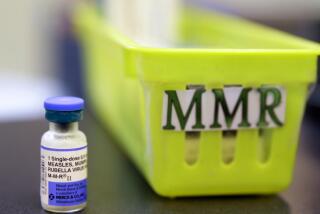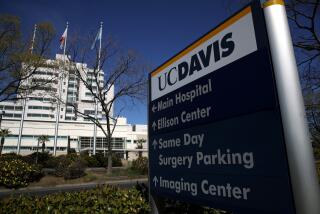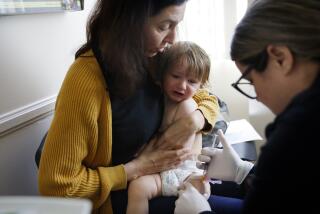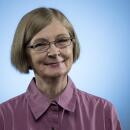Plunge in kindergartners’ vaccination rate worries health officials
California parents are deciding against vaccinating their kindergarten-age children at twice the rate they did seven years ago, a fact public health experts said is contributing to the reemergence of measles across the state and may lead to outbreaks of other serious diseases.
The percentage of kindergartens in which at least 8% of students are not fully vaccinated because of personal beliefs has more than doubled as well, according to data on file with the state. That threshold is significant because communities must be immunized at a high rate to avoid widespread disease outbreaks. It is a concept known as herd immunity, and for measles and whooping cough at least 92% of kids need to be immune, experts say.
High vaccination levels in the U.S. have helped millions of children avoid serious diseases and saved tens of thousands a year from paralysis, birth defects and death, experts say. But the risk of infectious disease remains a concern. Recent measles cases, for example, were brought into the country by travelers and quickly spread to several unvaccinated individuals.
“Five days a week, [children are] in their small classroom,” said Shannon Stokley, an epidemiologist at the National Center for Immunization and Respiratory Diseases, part of the Centers for Disease Control and Prevention. “That’s the perfect conditions for spreading germs and spreading infections.”
State law requires kindergartners to be vaccinated against measles, pertussis ( whooping cough), polio, mumps, rubella, hepatitis B, chicken pox, diphtheria and tetanus.
Parents who say immunization is against their personal beliefs can get exemptions. Some opt out of all the mandatory shots, while others allow students to get select vaccinations. There are also temporary and medical exemptions.
That makes exact vaccination rates hard to assess. But the upward trend in belief exemptions is troubling to health experts. California is coping with a whooping cough epidemic and earlier this year experienced a cluster of measles outbreaks, thanks in part to insufficient vaccination.
The anti-vaccination movement is being driven by parents who question the medical consensus that inoculations are safe. Some are concerned that vaccines could trigger autism — a theory that has been thoroughly discredited by scientists.
Holly Blumhardt, a mother of three unvaccinated children (two of them attend Orange County public school), said her family believes in staying healthy “from the inside out.” In her view, that means taking vitamin and mineral supplements, steering clear of genetically modified foods, getting regular chiropractic care and maintaining an “active lifestyle.”
“Most parents want to do the … healthiest thing for their child,” Blumhardt said. “It should be their choice.”
A Times analysis of the state figures found that the growth in personal-belief exemptions was particularly prevalent at private schools: Nearly 1 in 4 of those kindergartens reported at least 8% of their students were exempt from at least one vaccine last fall because of personal belief. In 2007, that figure was just 1 in 10. The rate for public school kindergartners last fall also more than doubled to 11% from 5% in 2007.
Overall, the rate of personal belief exemptions at California kindergartens with at least 10 students doubled to 3.1% last fall from 1.5% in 2007.
Exemption rates vary greatly by area and school. Los Angeles Unified kindergartens, for example, had an overall exemption rate of just 1.6%, although there are several in the district where more than 8% of students have belief exemptions. At Santa Monica-Malibu Unified, the overall exemption rate was 14.8% and at Capistrano Unified in south Orange County, it was 9.5%. At nearby Santa Ana Unified only 0.2% of kindergartners had exemptions on file.
In Los Angeles County, the rise in personal belief exemptions is most prominent in wealthy coastal and mountain communities, The Times analysis shows. The more than 150 schools with exemption rates of 8% or higher for at least one vaccine were located in census tracts where the incomes averaged $94,500 — nearly 60% higher than the county median.
“I’m 65. I was born right on the edge of the polio epidemic,” said Thomas Kaut, administrator at Montessori Children’s House of Shady Oaks in Redding, a private school where 40% of kindergartners had belief waivers. “I still feel like it’s a no-brainer. Some of these parents don’t understand the severity of these diseases.”
However, he said, the parents who choose his school are attracted to an alternative style of education, “so it makes sense that they might have different views about health.”
Tammy Murphy, superintendent of the Montecito Union School District in Santa Barbara, said she tries to respect parents’ decisions, while remaining mindful of risks to the school community.
“I don’t think they make this decision out of a place of ignorance. It’s one they’ve thought about deeply,” said Murphy, whose district kindergartners had a 27.5% belief exemption rate last fall. “They’re reading all about this and making what they feel is the best-informed decision they can for their child.”
At Santa Cruz Montessori in the small coastal community of Aptos, about 7% of kindergartners in 2007 got belief exemptions. Last fall, that rate was 22.6%.
Principal Kathy Rideout said the school has tried different approaches to encourage parents to immunize children. They asked a doctor to talk with fellow parents. They produced handouts emphasizing the importance of immunizations and asked parents seeking belief exemptions to get counseling from a healthcare practitioner. A state law that went into effect this year makes this a requirement.
But none of it made much difference, Rideout said. On average, about 13% of kindergartners had exemptions in the last five school years.
“My concern is not only for the health of the students here but also for the families that are members of the community,” Rideout said. “We know that it can be very dangerous for pregnant women and young infants” who have not been immunized to visit the school. It could also be a problem if students at the school are not vaccinated for medical reasons.
Said Assemblyman Richard Pan (D-Sacramento), who introduced the bill requiring parental counseling: “Hopefully we do not need to have children hospitalized and die before people will recognize how important it is to get their child immunized — and how important it is not just for their own child, but for the community at large.”
But in the end, say those who support the rights of parents to opt out, individual concerns trump community risk.
“It’s only ethical for a person to decide what risk they are willing to take with their body,” said Dawn Richardson of the National Vaccine Information Center, which argues for the right of parents to decide. The American Academy of Pediatrics, however, has said the group promotes unscientific approaches to vaccines. “No one group should demand that another group take a risk to benefit them, that’s where it crosses the line,” Richardson said.
The incidence of measles reached a 20-year high in the United States this year, with California reporting the second-largest number of cases at 61. Orange County was hardest hit, with 22 reported cases.
Of 42 cases for which the state has immunization data, 26 were unvaccinated, said Scott Sandow, a spokesman for the California Department of Public Health.
The state also is experiencing a whooping cough, or pertussis, epidemic, with more than 7,500 cases this year.
“We have schools in California where the percent of children who exercise the personal belief exemption is well above 50%,” said Dr. Gil Chavez, deputy director of the California Department of Public Health’s Center for Infectious Diseases. “That’s going to be a challenge for any disease that is vaccine preventable.”
Twitter: @palomaesquivel
More to Read
Sign up for Essential California
The most important California stories and recommendations in your inbox every morning.
You may occasionally receive promotional content from the Los Angeles Times.











